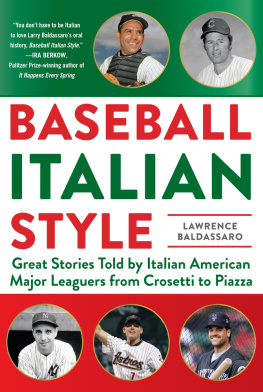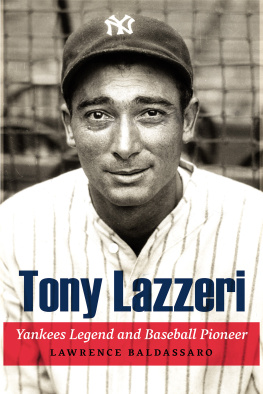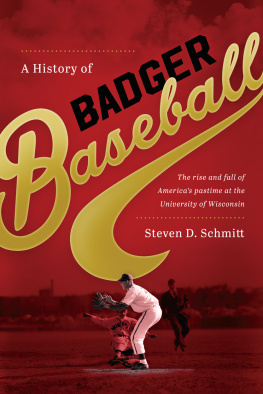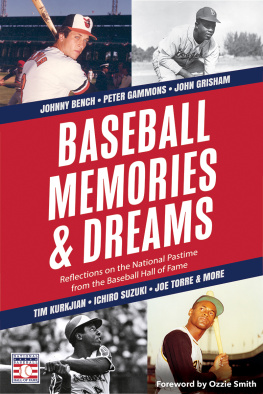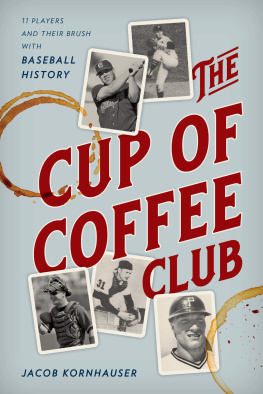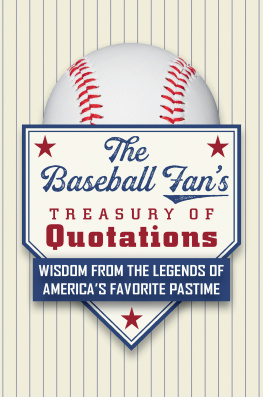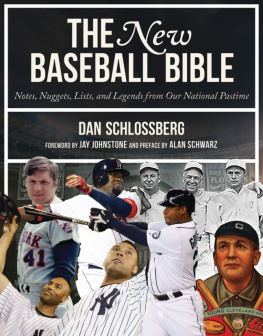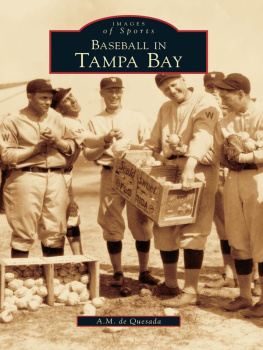Copyright 2018 by Lawrence Baldassaro
All rights reserved. No part of this book may be reproduced in any manner without the express written consent of the publisher, except in the case of brief excerpts in critical reviews or articles. All inquiries should be addressed to Sports Publishing, 307 West 36th Street, 11th Floor, New York, NY 10018.
Sports Publishing books may be purchased in bulk at special discounts for sales promotion, corporate gifts, fund-raising, or educational purposes. Special editions can also be created to specifications. For details, contact the Special Sales Department, Sports Publishing, 307 West 36th Street, 11th Floor, New York, NY 10018 or .
Sports Publishing is a registered trademark of Skyhorse Publishing, Inc., a Delaware corporation.
Visit our website at www.sportspubbooks.com.
10 9 8 7 6 5 4 3 2 1
Library of Congress Cataloging-in-Publication Data is available on file.
Cover design by Tom Lau
Cover photos credit: Associated Press
ISBN: 978-1-68358-111-6
Ebook ISBN: 978-1-68358-112-3
Printed in the United States of America
To the memory of my brother,
Gerald A. Baldassaro Jr.
CONTENTS
Note: Individuals are listed according to the decade they began their major-league career.
PREFACE
O n June 12, 1993, I sat in the visitors radio booth at County Stadium in Milwaukee, mesmerized by the delightful recollections of Phil Rizzuto. It had been thirty-seven years since the seventy-six-year-old Hall of Fame shortstop known as The Scooter had traded his glove for a microphone, but he still retained the boyish enthusiasm and innocence that had endeared him to Yankee fans and teammates. Speaking in his inimitable, rambling style, he reminisced about his family, growing up in Brooklyn, his Navy experiences during World War II, and his career as a Yankee. The interview ended when someone entered the booth with lunch. Rizzuto turned and asked, Got cannolis there?
That interview, the first I had conducted with an Italian American major leaguer, motivated me to interview many others, which in turn planted the seed for my previous book, Beyond DiMaggio: Italian Americans in Baseball , the first extensive history of the topic. For obvious reasons, Beyond DiMaggio contained only snippets of those interviews. Several more have been conducted since its publication in 2011. Baseball Italian Style brings all the interviews together in a single volume, enabling readers to hear them in their entirety. The goal of this book is twofold: to provide informative and entertaining reading for even casual baseball fans of all backgrounds, and to help preserve the long and distinguished legacy of Italian American participation in major-league baseball.
This collection differs from all other oral histories related to baseball not only in its focus on a single ethnic group but also in its scope of almost a century of major-league history, from the 1930s to the second decade of the twenty-first century. It provides, in microcosm, a chronicle of not only Italian American contributions to the national pastime but also of the evolution of the game itself and the many changes that have occurred on and off the field. The earliest recollections come from men whose careers began in the 1930s and coincided with those of such legendary figures as Babe Ruth, Connie Mack, Jimmie Foxx, Rogers Hornsby, Hank Greenberg, and Ted Williams. The interviews then progress chronologically through the decades, into the eras of racial integration, artificial turf, interleague and divisional play, labor strife, free agency, astronomical salaries, performance-enhancing drugs, and around-the-clock media coverage.
The forty-four narrators comprise a broad representation of Italian American participation in major-league baseball. They include Hall of Famers and Most Valuable Players, as well as stars from each decade and players with less illustrious careers. In addition, you will hear from coaches, managers, front-office executives, and umpires. Their experiences differ, as do the longevity and quality of their careers, and they come from a wide range of geographical, educational, and socioeconomic backgrounds. What they share, in addition to their Italian heritage, are a lifelong passion and respect for the game, vivid memories of their careers, and engaging stories. Their recollections are often astonishingly detailed, no matter how long ago the incidents occurred. Nevertheless, while there is material that will be of interest to historians, this is a book of personal recollections; as such, given the imperfection of human memory, it in no way pretends to provide an infallible historical document.
The inspiration and model for this collection is The Glory of Their Times: The Story of the Early Days of Baseball Told by the Men Who Played It, the late Lawrence Ritters 1966 seminal work which remains the benchmark for any oral history related to baseball. Following the example established by Ritter, I have done minimal editing to the original interviews, primarily eliminating my questions and occasionally rearranging the order to provide continuity and chronological context to the contents of each interview and to make them more readable.
Many people contributed in various ways to the making of Baseball Italian Style . My thanks to Emi Battaglia, Michael Bauman, Dan Bonanno, Frank Catalanotto, Larry Freundlich, Frank Gado, Bob Gormley, Dick Johnson, Joe Quagliano, George Randazzo, and Mario Ziino. Im also grateful to those who helped in securing photos: Robbin Barnes, Bob Cullum, Mary Jo Giuliani, Brendan Hader, Ed Hartig, John Horne, Michael Ivins, Dave Kaplan, Debra Kaufman, Marco Landi, Diane Lodigiani, Suzanna Mitchell, and Mario Salvini.
Im deeply indebted to my editor, Ken Samelson, for his accessibility and his patient and knowledgeable guidance throughout this project. Thanks also to Kens Sports Publishing colleagues Marion Schwaner and Sarah Jones as well as proofreader Sean Sabo. And to Gael Garbarino, la mia cara amica , special thanks for her wise counsel and invaluable moral support.
As I mentioned earlier, this book is the offspring of Lawrence Ritters The Glory of Their Times . I was fortunate to count Larry among my friends, and I will always be grateful for his support and inspiration. One of the books I treasure most is my first edition copy of The Glory of Their Times, which Larry graciously inscribed to me in June 1999: For my pal Larry B. With every good wish, Ciao, Larry Ritter.
My greatest debt of gratitude, of course, is owed to the narrators who made this book possible by so generously sharing their memories with me. Meeting all these major leaguers and listening to their stories was a great pleasure and privilege. I hope you find reading their stories as entertaining and informative as I did listening to them.
INTRODUCTION
B aseball has changed in many ways since Yankees shortstop Frank Crosetti, our leadoff narrator, made his big league debut in 1932, a time when games were played only in the daytime, players traveled by train, shared rooms with teammates while on the road, made about as much money as the writers who covered them, and worked in the offseason. But in its most fundamental aspects, the game remains what it was at the turn of the twentieth century.
More than any other American sport, baseball is firmly rooted in history and tradition. The players, and even some teams, come and go, but the action unfolds on the same stage. The game links us to earlier generations, to our own childhood, and to our children. Fans are familiar not only with the heroes of today and their youth but also with the legends of earlier generations. If they shift their minds into reverse, older fans can see their heroes as they remember them. They, in turn, pass their memories on to their children. The players we cheer today are part of a tradition that goes back to the first men to put on a uniform.

